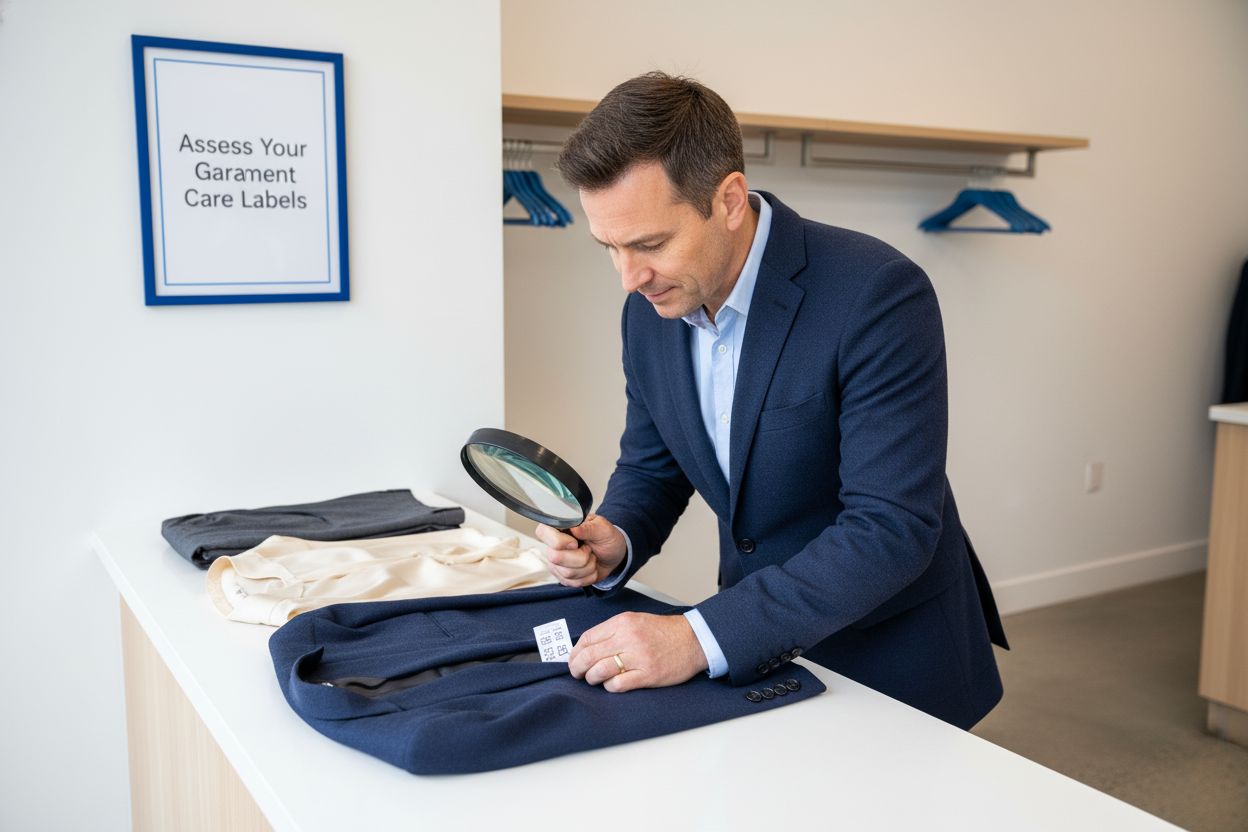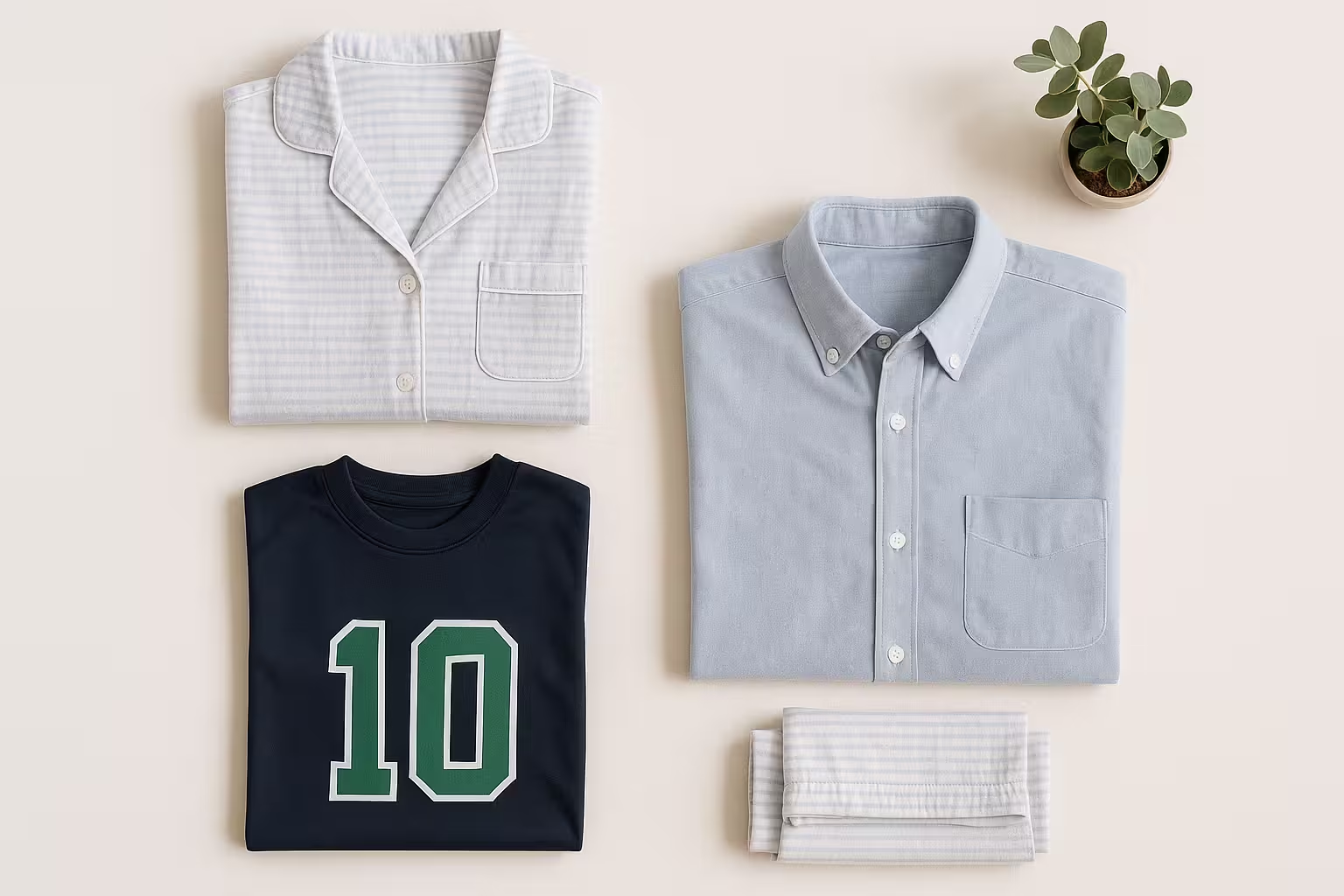How to get rid of yellow stains on white clothes: Easy steps
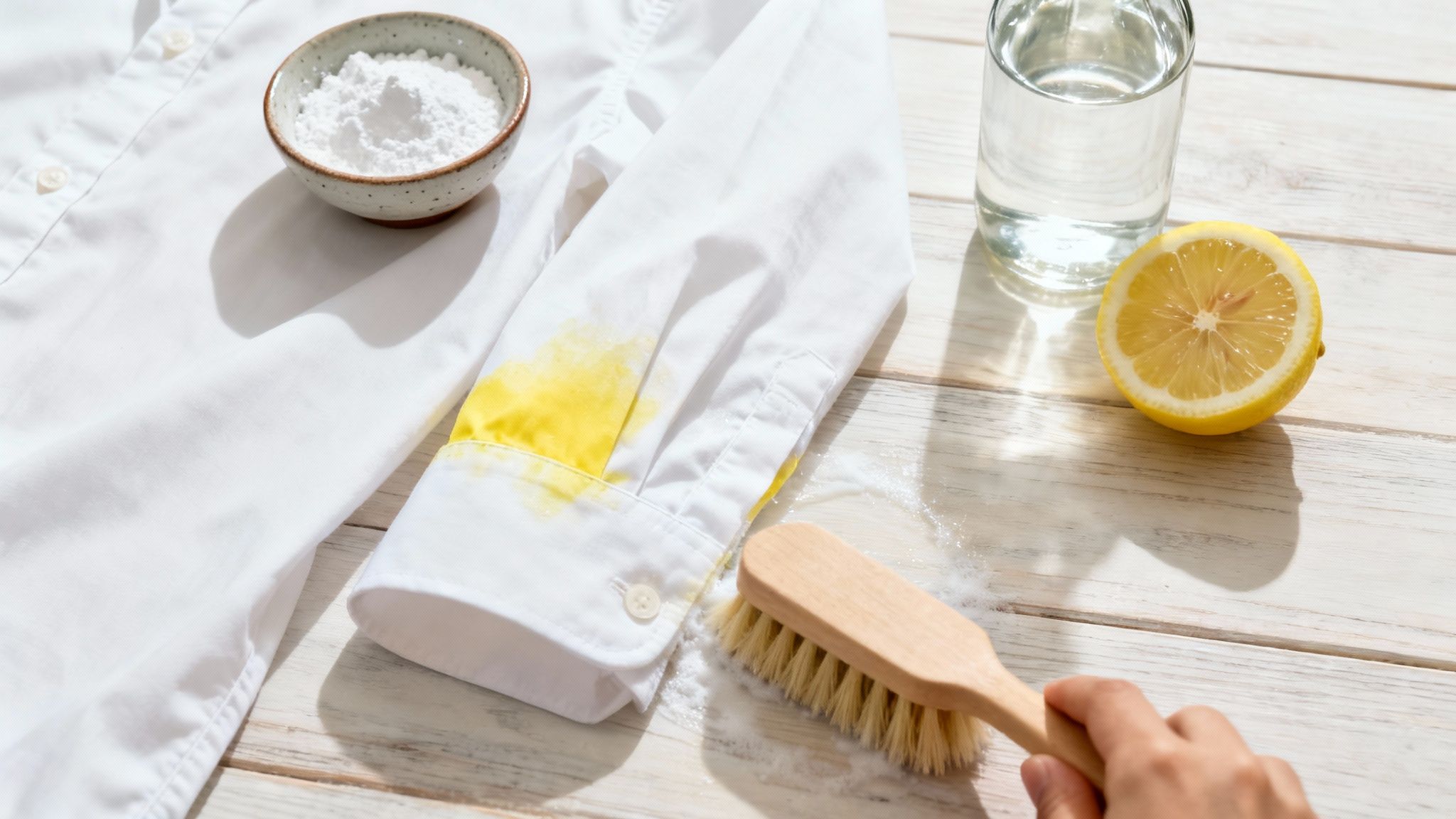
It’s one of the most frustrating laundry mysteries: you pull out your favorite white t-shirt, only to find a dingy, yellow stain that definitely wasn't there before. Before you can get rid of it for good, you need to play detective and figure out what caused it in the first place.
These stubborn marks rarely just appear out of thin air. They're usually the result of a slow-building chemical reaction happening right in the fabric.
Understanding the cause is half the battle. This is a super common problem—in fact, studies show that up to 70% of households deal with yellowing on their white clothes every year. And what's the number one culprit? A global survey found that 63% of people blame sweat and body oils, making it the most frequent offender in our laundry baskets. You can find even more expert advice on stain removal from the American Cleaning Institute.
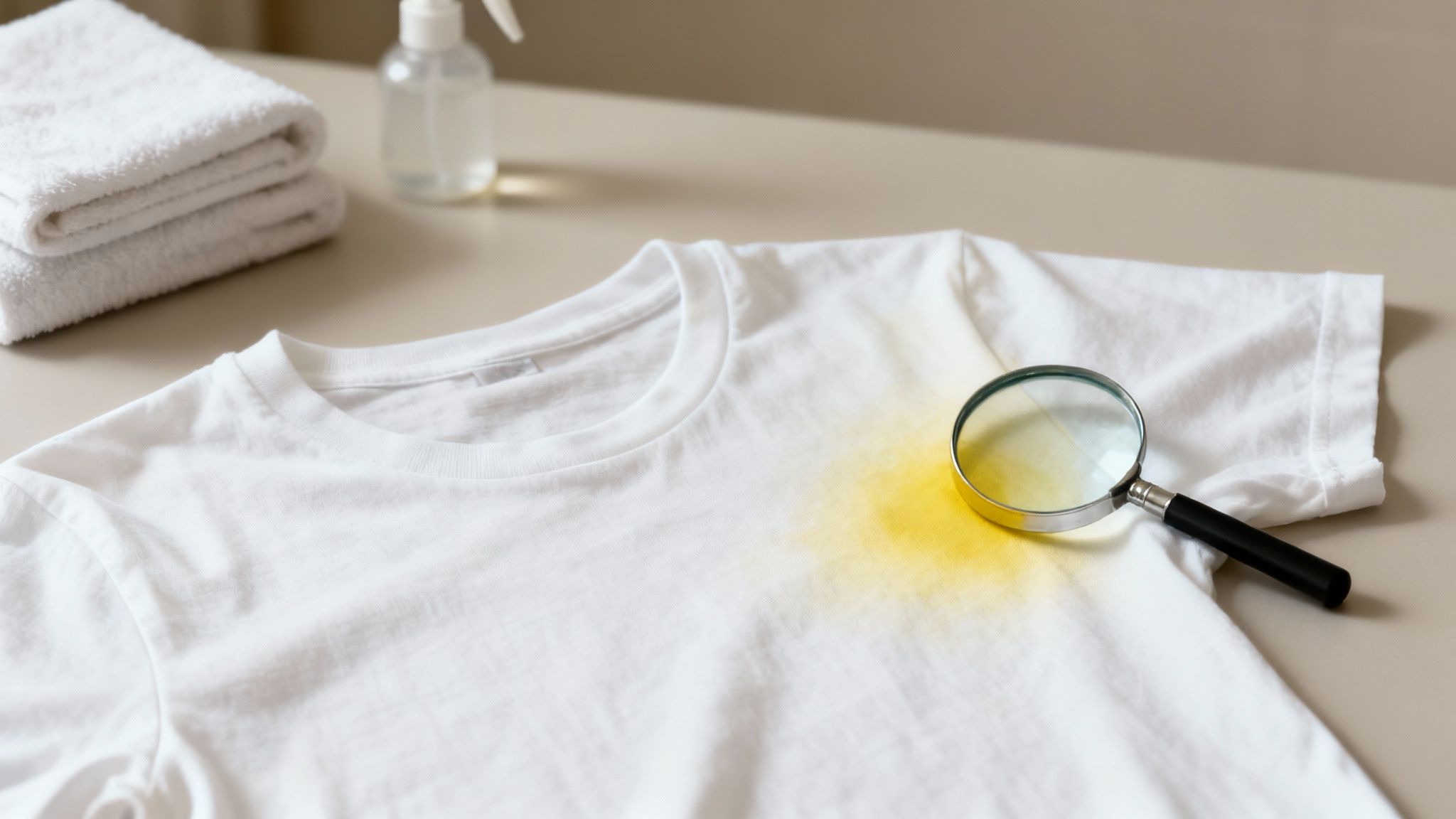
The Main Culprits Behind Yellowing
So, what’s really going on? More often than not, that yellowing around the collar and underarms is from a basic chemical reaction. The proteins in your sweat are mingling with the aluminum compounds found in most deodorants and antiperspirants. Over time, this mixture seeps deep into the fabric fibers, creating a tough yellow stain that only seems to get worse after washing.
Another sneaky cause is the slow oxidation of body oils left on the fabric. A shirt might look perfectly clean when you put it away, but microscopic residue can still be lurking. When that garment is stored for a season and exposed to air, those oils oxidize and turn yellow, leaving you with a dingy surprise when you pull it out again.
Key Takeaway: Yellow stains are often not from a single spill but a gradual buildup of sweat, body oils, and product residue that reacts with fabric over time. Washing clothes soon after wearing is a crucial preventative step.
Finally, your own washing habits—and even your water—could be to blame.
- Hard Water Deposits: If your home has hard water, it's packed with minerals like iron. These can leave deposits on your clothes that build up over time, giving your whites an overall yellow tint.
- Detergent Overload: It’s tempting to think more is better, but using too much laundry detergent or fabric softener creates a sticky residue. This film is a magnet for dirt and body oils, which leads straight to discoloration.
Once you’ve identified the likely source of the stain, you can pick a targeted treatment instead of just blasting it with harsh chemicals that might do more harm than good.
Quick Guide to Yellow Stain Causes and Initial Treatments
To help you get started, here’s a quick-reference table that matches common causes with the best first-aid treatment for your clothes.
This table should give you a solid starting point for tackling those pesky stains head-on. By diagnosing the problem correctly, you're already on your way to restoring your whites to their bright, clean best.
Using Natural Stain Removers From Your Pantry
Before you reach for the heavy-duty chemicals, take a peek in your kitchen pantry. You might be surprised to find some incredibly effective, fabric-safe solutions for those stubborn yellow stains. The best part? These common household items work their magic using simple, gentle science—no harsh additives required.
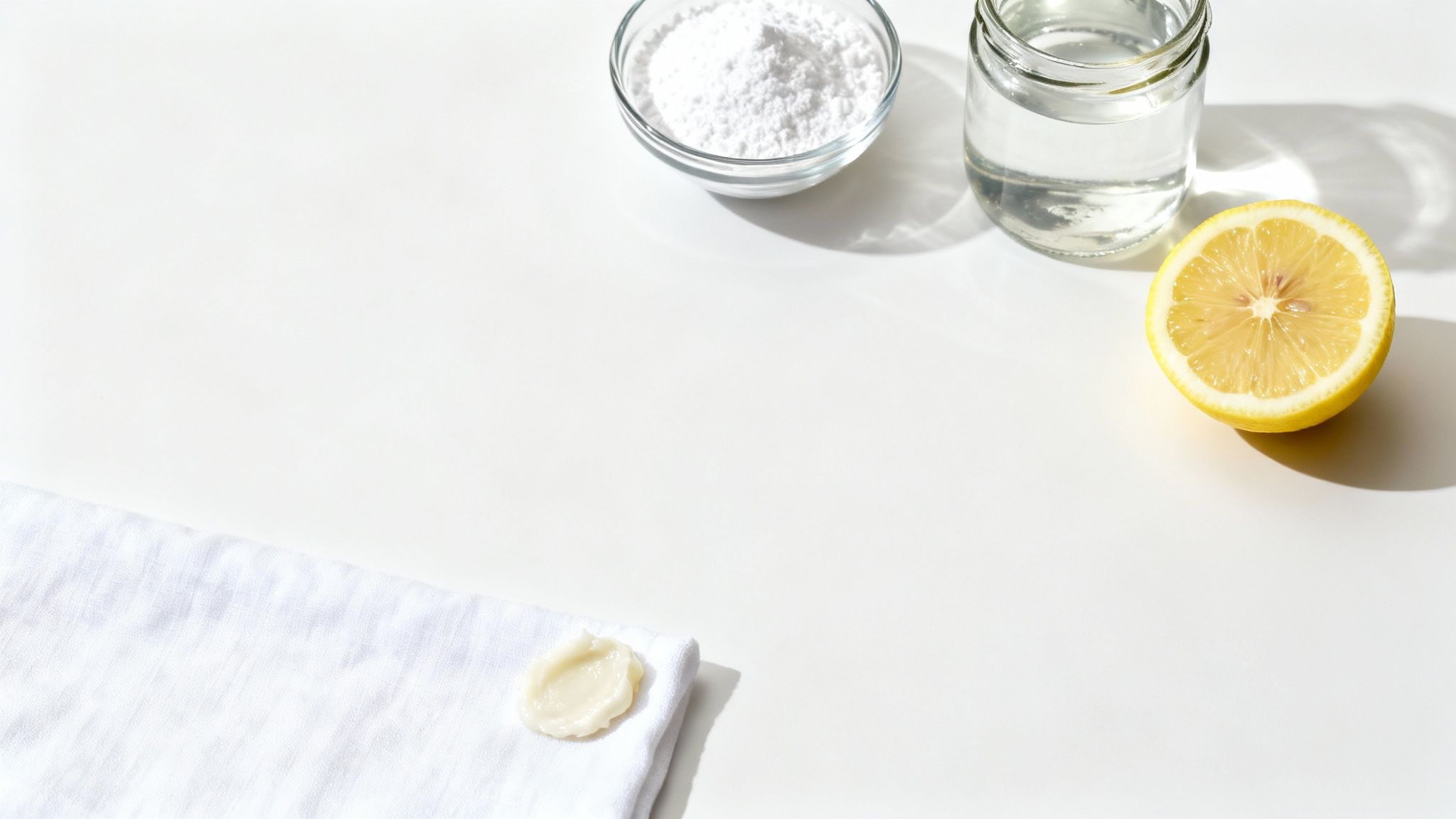
Often, learning how to get rid of yellow stains on white clothes is just a matter of understanding how these everyday ingredients work. From the gentle scrubbing power of baking soda to the acidic punch of vinegar and lemon juice, these pantry staples are a fantastic first line of defense.
The Power of a Baking Soda Paste
Baking soda is a go-to in my laundry room, and for good reason. It’s a mild abrasive that physically lifts stains out of fabric fibers without causing any damage. As a bonus, it’s also a fantastic odor neutralizer, which is perfect for tackling sweat stains.
Here’s how to put it to work:
- Mix four tablespoons of baking soda with about a quarter cup of warm water.
- Stir it up until you have a smooth, spreadable paste.
- Gently rub this mixture right onto the yellowed areas. For tougher spots on sturdy fabrics like cotton, I like to use an old, soft toothbrush to really work it in.
Let that paste sit on the garment for at least 30 minutes, but an hour is even better. This gives the baking soda time to break down the bonds between the stain and the fabric. Afterward, just toss it into the washing machine and run a normal cycle.
Harnessing the Acidity of White Vinegar and Lemon Juice
Distilled white vinegar is another hero of natural laundry care. Its acetic acid is brilliant at dissolving the mineral deposits from hard water and breaking down the oils and proteins in sweat. In a similar vein, the citric acid in lemon juice acts as a natural bleaching agent, brightening whites and helping to fade that yellow dinginess.
For an all-over brightening soak, add one cup of distilled white vinegar to a basin of hot water. Submerge your white clothes completely and let them soak for at least an hour—or even overnight if you're dealing with serious yellowing. The vinegar gets to work brightening the fabric and knocking out any lingering odors. Once the soak is done, wring out the clothes and wash them as usual to get rid of any vinegar smell. This method is a lifesaver for tackling overall dinginess.
Pro Tip: For a more targeted approach, mix equal parts lemon juice and water and apply it directly to a stain. Lay the garment out in the sun for an hour or two; the UV rays will actually boost the natural bleaching effect of the lemon juice. Just be sure to test this on a hidden spot first, especially with delicate fabrics.
And if you find yourself facing some truly formidable stains, it might be time to explore more intensive cleaning techniques. Learning about things like laundry stripping with borax can give you another powerful tool for your toughest laundry challenges. But by starting with these simple, natural methods, you can often bring your favorite white clothes back to life without ever needing to buy a special stain remover.
Advanced Tactics for Stubborn Yellow Stains
So, you’ve tried the pantry staples and those pesky yellow stains are still hanging around. Don't throw in the towel just yet. When you’re dealing with stubborn, set-in discoloration—especially on clothes you just pulled out of storage—it’s time to bring out the heavy hitters.
This is where specialized detergents and soaking agents become your best friends.
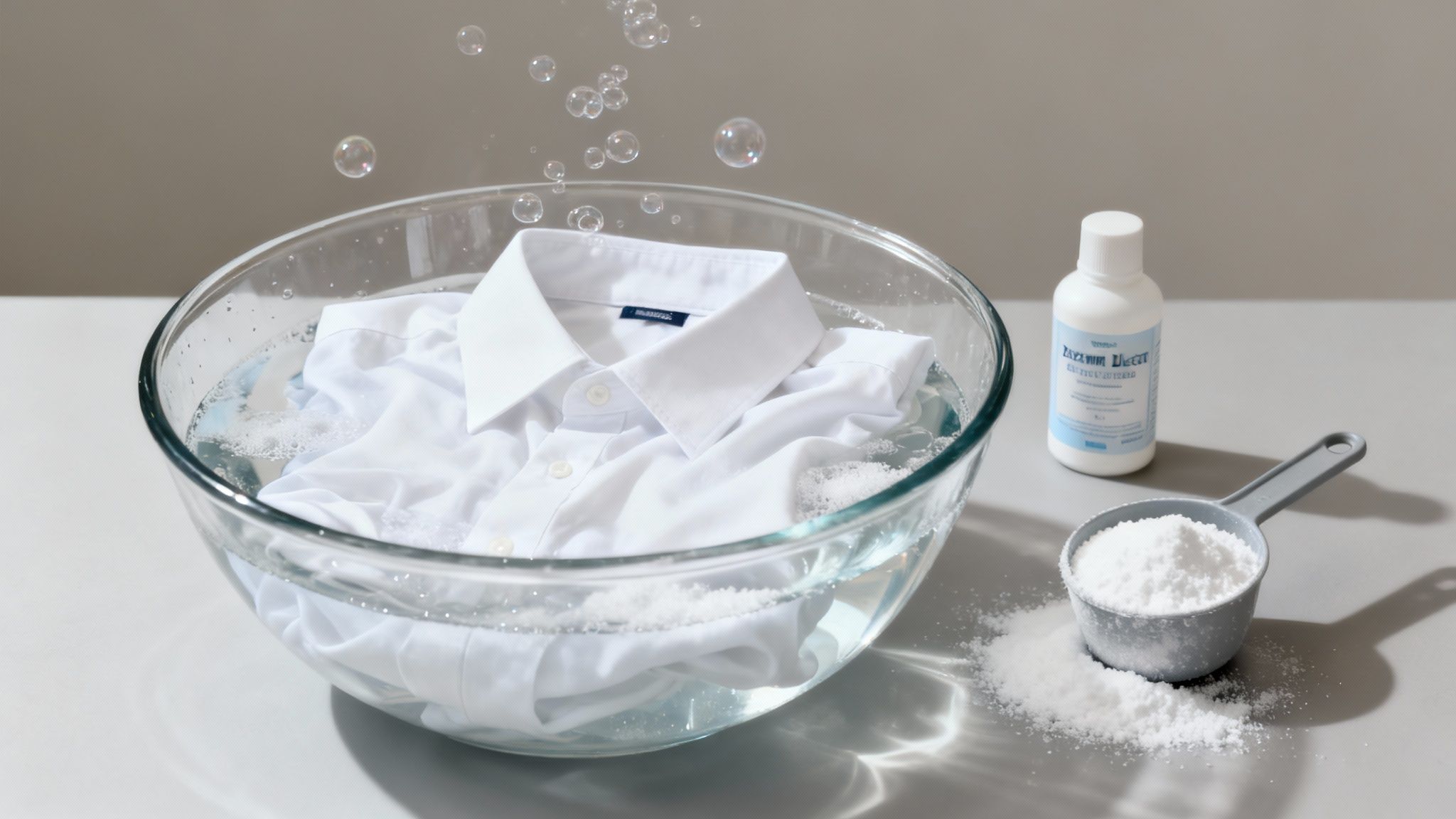
These more advanced methods are designed to break down the tough, aged compounds causing that deep-seated yellowing. Instead of just treating the surface, these techniques get deep into the fabric fibers to dissolve and lift away the source of the stain for good.
Harness the Power of an Enzyme Pre-Soak
If you're battling stains from sweat or body oils, an enzyme-based detergent is your secret weapon. These formulas are packed with proteins that are specifically designed to target and break down other proteins, fats, and starches—the very things that make up those frustrating yellow marks. A good, long pre-soak gives these enzymes the time they need to work their magic.
This isn't just a quick dip; it's a strategic, extended soak. Oxidation stains, which cause that familiar yellowing, affect roughly 35% of stored white clothing. But here's the good news: presoaking with an enzyme detergent in hot water for up to eight hours is effective in 75% of cases when followed by a normal wash.
To get the most out of an enzyme soak, here's what to do:
- Fill a basin or your tub with the hottest water the garment’s care label allows.
- Add a dose of a high-quality, enzyme-based laundry detergent and swish it around to dissolve.
- Submerge your stained white clothes completely, making sure every inch is saturated.
- Let them soak for at least four hours, or even up to eight for really deep-set stains.
This extended bath gives the enzymes plenty of time to literally digest the stain, making it much easier for your washing machine to finish the job. It’s one of the most reliable ways I know to restore a garment that looks like a lost cause.
Using Oxygen Bleach for Safe and Effective Whitening
When you need serious whitening power but want to avoid the harshness of chlorine bleach, oxygen bleach is the answer. Chlorine bleach can be a disaster on certain stains—it can weaken fibers and even cause a chemical reaction that makes protein-based stains look worse. Oxygen bleach, on the other hand, is color-safe and works by releasing tiny oxygen bubbles to gently lift stains and brighten fabrics.
Important Note: Always, always check the care label on your garment before using any type of bleach. While oxygen bleach is safe for most fabrics, you should never use it on delicate materials like silk, wool, or leather.
For an all-over whitening boost, just mix a powdered oxygen bleach with water according to the package directions. Submerge your clothes and let them soak for several hours or even overnight. This gentle yet powerful process is fantastic for reviving an entire load of dingy whites.
If you're dealing with really extensive buildup from detergents or fabric softeners over time, you might want to look into other deep-cleaning methods. For those situations, it can be helpful to understand the process of stripping laundry to fully remove all that residue.
The Future Of Keeping Clothes White
The world of laundry care is always changing, slowly but surely moving past the traditional soaps and soaks we grew up with. We're heading toward smarter, more sustainable ways to keep our clothes looking their best. While all the pantry remedies and powerful enzyme detergents we've talked about are fantastic tools, the next big thing in stain removal promises to be even gentler on our favorite fabrics—and the planet.
Imagine a future where you can zap stubborn yellow stains without a single drop of harsh chemicals. It sounds a bit like science fiction, doesn't it? But it's actually the direction laundry tech is moving. Researchers are figuring out how to target stains at a molecular level, which could completely change how we think about getting rid of yellow stains on white clothes. One of the most fascinating developments is all about the power of light.
Light-Based Stain Removal
Believe it or not, scientists are proving that specific wavelengths of light can break down the very compounds that cause yellowing in our clothes. This method goes straight for the stain itself, meaning no more abrasive scrubbing or soaking in chemicals that can wear down delicate fibers over time. It's a whole new approach.
One pretty incredible study found that high-intensity blue LED light could remove yellow stains from fabrics with an 85% success rate. That’s a huge leap compared to the 70% success rate of a standard hydrogen peroxide treatment. What's really impressive, though, is that the light-based method caused zero measurable fiber damage. This makes it an incredibly promising, sustainable alternative to chemical oxidants. You can read more about this innovative stain removal research if you're curious.
This marks a huge shift from relying on chemical reactions to using physical ones. We could be looking at a future where whitening clothes is as simple as exposing them to a specific type of light. It’s a cleaner, safer, and potentially much more effective way forward.
Comparing Future And Current Methods
Now, you won't find these light-based gadgets on store shelves just yet. But they point to a clear trend: cleaning methods are becoming more precise and less damaging. It's helpful to see how this emerging technology stacks up against what we use today.
As these kinds of advancements eventually make their way into our homes, we can expect laundry care to get more automated and much friendlier to our clothes. The focus will shift from brute-force chemicals to intelligent systems that preserve the life and look of our favorite whites for years to come.
How To Prevent Yellow Stains On Clothes

While getting good at stain removal is a useful skill, the absolute best way to handle yellow stains is to stop them from ever showing up. It just takes a few simple, proactive habits in your laundry routine to make a world of difference, keeping your white garments looking crisp for much longer.
The whole idea is to prevent the buildup of the stuff that causes yellowing in the first place. That means getting rid of sweat, body oils, and deodorant residue before they have a chance to settle into the fabric and oxidize over time.
Think of it like brushing your teeth—a little daily maintenance goes a long way and is much easier than fixing a problem later. The same logic applies to your favorite white tees and dress shirts.
Adopt Smart Washing Habits
Small tweaks to how you do your laundry can have a massive impact. It often starts with something simple, like resisting the urge to cram the machine full. An overloaded washer just can't do its job; clothes need room to move so water and detergent can circulate and rinse away all the grime.
Always, always wash your whites separately from colors. This isn't just about preventing that stray red sock from turning everything pink. It lets you use cycles and temperatures ideal for whites, like warm or hot water (for durable fabrics like cotton), which are much better at breaking down oils.
Here are a few key practices to make part of your routine:
- Wash After Each Wear: This is non-negotiable for things like undershirts, gym clothes, and anything worn close to the skin. Washing them right away stops sweat and oils from embedding deep into the fabric.
- Use the Right Amount of Detergent: More is definitely not better here. Using too much detergent leaves behind a sticky film that actually attracts more dirt and residue, leading to a dingy, yellowed look over time.
- Go Easy on the Fabric Softener: Just like with detergent, overusing fabric softener can create a coating on your clothes that traps dirt and contributes to discoloration.
Key Insight: Consistency is your most powerful tool. By regularly washing whites the right way and storing them properly, you stop the chemical reactions that lead to yellowing before they even get a chance to start.
Master Your Storage Strategy
How you store your whites is just as critical as how you wash them. The name of the game is limiting their exposure to the very things that cause oxidation and yellowing.
A cool, dry, and dark place like a closet is perfect. Whatever you do, avoid storing white garments in plastic bags or airtight containers for long stretches. Plastic traps moisture and kills airflow, creating a perfect storm for mildew to grow and for any leftover body oils to oxidize and turn yellow.
Instead, go for breathable storage solutions like cotton garment bags. They protect your clothes while still letting air circulate.
And for the final, most crucial step: make sure every single piece of clothing is completely clean and bone-dry before you pack it away for the season. Even a little bit of lingering moisture or an invisible spot of residue is just a future yellow stain waiting to happen. For a deeper dive into proactive garment care, check out these simple habits to prevent stains for even more great strategies.
Common Questions About Removing Yellow Stains
Even when you follow all the right steps, some yellow stains just seem to have a mind of their own. When you're trying to figure out how to get yellow stains out of white clothes, a few questions always seem to come up. Let's bust some common myths and get you clear answers for those really stubborn situations.
Sometimes, success is all about knowing which tool to grab—and more importantly, which ones to leave on the shelf. The right move can save a shirt you love, but the wrong one can lock that stain in for good.
Can I Use Chlorine Bleach on All Yellow Stains?
It's so tempting to reach for chlorine bleach, thinking it's the ultimate weapon against stains. But for yellowing, it's often the absolute worst thing you can do.
While it's a powerful whitener, chlorine bleach can have a nasty chemical reaction with the proteins in sweat and body oil. Instead of lifting the stain, it can actually make the yellowing more intense and permanent. It's like pouring gasoline on a fire.
Plus, chlorine bleach is incredibly harsh and can destroy delicate fibers. You should never use it on fabrics like:
- Silk
- Wool
- Leather
- Spandex
Always, always check the care label on your garment first. A much safer and more reliable choice is an oxygen-based bleach. It gets the job done without eating away at the fabric.
Key Takeaway: Chlorine bleach is a huge risk for yellow stains, especially from sweat. It can react with proteins and set the stain forever. Stick with a safer alternative like oxygen bleach for much better (and more predictable) results.
Why Did My Stored White Clothes Turn Yellow?
Has this ever happened to you? You pull a perfectly clean white shirt from storage, only to find it has developed mysterious yellow splotches. It’s incredibly frustrating.
This phantom stain is usually caused by oxidation. It happens when invisible residues—leftover body oils or even tiny amounts of detergent—react with the air over several months.
The secret to preventing this is all in the prep work. Before you pack anything away for the season, make sure every single item is washed thoroughly and is 100% dry. It’s also a good idea to skip the plastic bags or bins. Plastic traps moisture and kills airflow, creating the perfect storm for oxidation to happen. Breathable cotton garment bags are a much smarter choice for keeping your whites bright.
How Do I Remove Old Stains from Vintage Clothes?
Tackling vintage or antique fabrics requires a gentle touch. These older materials are often fragile, so aggressive scrubbing and harsh chemicals are completely off the table. For those yellow, set-in stains on a precious family heirloom, patience is truly your best virtue.
Your safest bet is a long, gentle soak. Find a basin, fill it with cool water, and mix in a powdered oxygen-based bleach according to the package directions. Submerge the garment, making sure it’s completely covered, and just let it sit. This might take a while—sometimes up to 24 hours.
This slow-and-steady approach lets the oxygen gently work its magic, lifting the discoloration without stressing the delicate old fibers. Afterward, carefully hand-wash it with a mild detergent and let it air dry away from direct sunlight, which could set any faint traces of the stain that remain.
You've worked hard to bring your whites back to life. Why not let Columbia Pike Laundry take the work off your hands for good? We give you permission to reclaim your weekend. Schedule a pickup and we’ll handle the rest, returning your clothes perfectly clean and cared for. Find out more at https://columbiapikelaundry.com.
Popular Blog Articles

Meet the Author
Daniel Logan didn’t start CPL because he loved laundry. He started it because his family was drowning in time debt, and laundry was one of the biggest weights.
Mornings were chaos with two kids under 5. Evenings felt like catch-up. And weekends? Gone to sorting socks and folding piles.
He knew his story wasn’t unique. So he built a business that gave families like his just a little bit of breathing room one load at a time.
With no laundry experience but deep tech skills, Daniel rolled up his sleeves, doing every job himself while building systems that turned it into a modern laundry service that saves customers time, simplifies their lives, and delivers reliability they can count on.
That’s where CPL began. Not from a playbook, but from pain. From one dad trying to buy back time: for himself, and for every household like his.



